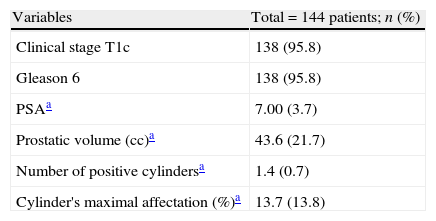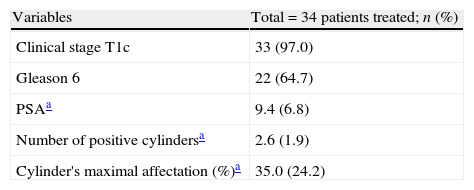To evaluate the acceptance of active monitoring by patients treated in our healthcare community and to report the clinical results of an active surveillance program in patients with low-risk prostate cancer.
Materials and methodsProspective study of patients enrolled in an active surveillance program at our center between 2004 and 2012. The inclusion criteria were PSA<10ng/ml, Gleason score≤6, clinical stage T1c/T2a, ≤2 positive cores, and no more than 50% of the core being affected. Curative treatment was proposed when faced with pathological progression over the course of the monitoring.
ResultsIn 2011, only 17% of the total number of potential candidate patients rejected their inclusion in a surveillance program and were treated actively. We analyzed a series of 144 patients included in our active surveillance protocol. The mean follow-up time was 3.22 years (SD 2.08). A total of 110 patients (76.3%) remained under active monitoring, with an estimated median treatment-free survival after diagnosis of 6.9 years (95% CI: 6.2–7.6). The percentage of patients who remained free of treatment at 2 and 5 years was 96.3% (95% CI: 92.8–99.8%) and 70.9% (95% CI: 59.3–85.5%), respectively. Thirty-four patients (23.6%) required curative treatment. The mean time to treatment was 4.6 years (SD 2.3).
ConclusionsActive surveillance of highly selected patients with low-risk prostate cancer is a valid alternative therapy that is accepted by patients in our community.
Evaluar la aceptación del seguimiento activo por los pacientes en nuestro entorno asistencial y describir los resultados clínicos de un programa de vigilancia activa en pacientes con cáncer de próstata de bajo riesgo.
Material y métodosEstudio prospectivo de pacientes incluidos en programa de vigilancia activa en nuestro centro entre 2004 y 2012. Los criterios de inclusión fueron: PSA <10ng/ml, Gleason ≤6, estadio clínico T1c/T2a, ≤2 cilindros positivos, con una afectación máxima del cilindro del 50%. Se propuso tratamiento curativo ante la progresión anatomopatológica a lo largo del seguimiento.
ResultadosEn el año 2011, del total de pacientes potenciales candidatos, tan solo un 17% de los mismos rechazó la inclusión en un programa de vigilancia y fue tratado de forma activa. Analizamos una serie de 144 pacientes incluidos en nuestro protocolo de vigilancia activa. La media de seguimiento fue de 3,22 años (DE: 2,08). Ciento diez pacientes (76,3%) permanecen en seguimiento activo, con una mediana estimada de supervivencia libre de tratamiento tras el diagnóstico de 6,9 años (IC 95%: 6,2-7,6%). El porcentaje de pacientes que permanecen libres de tratamiento a 2 y 5 años fue de 96,3% (IC 95%: 92,8-99,8%) y 70,9% (IC 95%: 59,3-85,5%) respectivamente. Treinta y cuatro pacientes (23,6%) precisaron tratamiento curativo. La media de tiempo hasta el tratamiento fue de 4,6años (DE: 2,3).
ConclusionesLa vigilancia activa en pacientes altamente seleccionados con cáncer de próstata de bajo riesgo es una alternativa terapéutica válida de tratamiento y aceptada por los pacientes de nuestro entorno.










